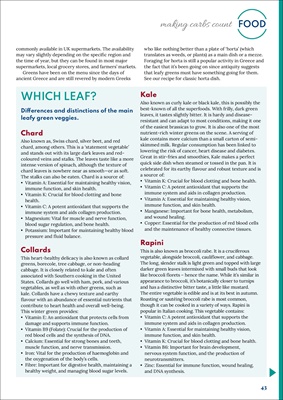
43
FOOD
making carbs count
commonly available in UK supermarkets. The availability
may vary slightly depending on the specific region and
the time of year, but they can be found in most major
supermarkets, local grocery stores, and farmers' markets.
Greens have been on the menu since the days of
ancient Greece and are still revered by modern Greeks
who like nothing better than a plate of 'horta' (which
translates as weeds, or plants) as a main dish or a mezze.
Foraging for horta is still a popular activity in Greece and
the fact that it's been going on since antiquity suggests
that leafy greens must have something going for them.
See our recipe for classic horta dish.
WHICH LEAF?
Differences and distinctions of the main
leafy green veggies.
Chard
Also known as, Swiss chard, silver beet, and red
chard, among others. This is a 'statement vegetable'
and stands out with its large dark leaves and redcoloured
veins and stalks. The leaves taste like a more
intense version of spinach, although the texture of
chard leaves is nowhere near as smooth-or as soft.
The stalks can also be eaten. Chard is a source of:
• Vitamin A: Essential for maintaining healthy vision,
immune function, and skin health.
• Vitamin K: Crucial for blood clotting and bone
health.
• Vitamin C: A potent antioxidant that supports the
immune system and aids collagen production.
• Magnesium: Vital for muscle and nerve function,
blood sugar regulation, and bone health.
• Potassium: Important for maintaining healthy blood
pressure and fluid balance.
Collards
This heart-healthy delicacy is also known as collard
greens, borecole, tree cabbage, or non-heading
cabbage. It is closely related to kale and often
associated with Southern cooking in the United
States. Collards go well with ham, pork, and various
vegetables, as well as with other greens, such as
kale. Collards have a chewy texture and earthy
flavour with an abundance of essential nutrients that
contribute to heart health and overall well-being.
This winter green provides:
• Vitamin E: An antioxidant that protects cells from
damage and supports immune function.
• Vitamin B9 (Folate): Crucial for the production of
red blood cells and the synthesis of DNA.
• Calcium: Essential for strong bones and teeth,
muscle function, and nerve transmission.
• Iron: Vital for the production of haemoglobin and
the oxygenation of the body's cells.
• Fibre: Important for digestive health, maintaining a
healthy weight, and managing blood sugar levels.
Kale
Also known as curly kale or black kale, this is possibly the
best-known of all the superfoods. With frilly, dark green
leaves, it tastes slightly bitter. It is hardy and diseaseresistant
and can adapt to most conditions, making it one
of the easiest brassicas to grow. It is also one of the most
nutrient-rich winter greens on the scene. A serving of
kale contains more calcium than a small carton of semiskimmed
milk. Regular consumption has been linked to
lowering the risk of cancer, heart disease and diabetes.
Great in stir-fries and smoothies, Kale makes a perfect
quick side dish when steamed or tossed in the pan. It is
celebrated for its earthy flavour and robust texture and is
a source of:
• Vitamin K: Crucial for blood clotting and bone health.
• Vitamin C: A potent antioxidant that supports the
immune system and aids in collagen production.
• Vitamin A: Essential for maintaining healthy vision,
immune function, and skin health.
• Manganese: Important for bone health, metabolism,
and wound healing.
• Copper: Essential for the production of red blood cells
and the maintenance of healthy connective tissues.
Rapini
This is also known as broccoli rabe. It is a cruciferous
vegetable, alongside broccoli, cauliflower, and cabbage.
The long, slender stalk is light green and topped with large
darker green leaves intermixed with small buds that look
like broccoli florets - hence the name. While it's similar in
appearance to broccoli, it's botanically closer to turnips
and has a distinctive bitter taste, a little like mustard.
The entire vegetable is edible and is at its best in autumn.
Roasting or sautéing broccoli rabe is most common,
though it can be cooked in a variety of ways. Rapini is
popular in Italian cooking. This vegetable contains:
• Vitamin C: A potent antioxidant that supports the
immune system and aids in collagen production.
• Vitamin A: Essential for maintaining healthy vision,
immune function, and skin health.
• Vitamin K: Crucial for blood clotting and bone health.
• Vitamin B6: Important for brain development,
nervous system function, and the production of
neurotransmitters.
• Zinc: Essential for immune function, wound healing,
and DNA synthesis.